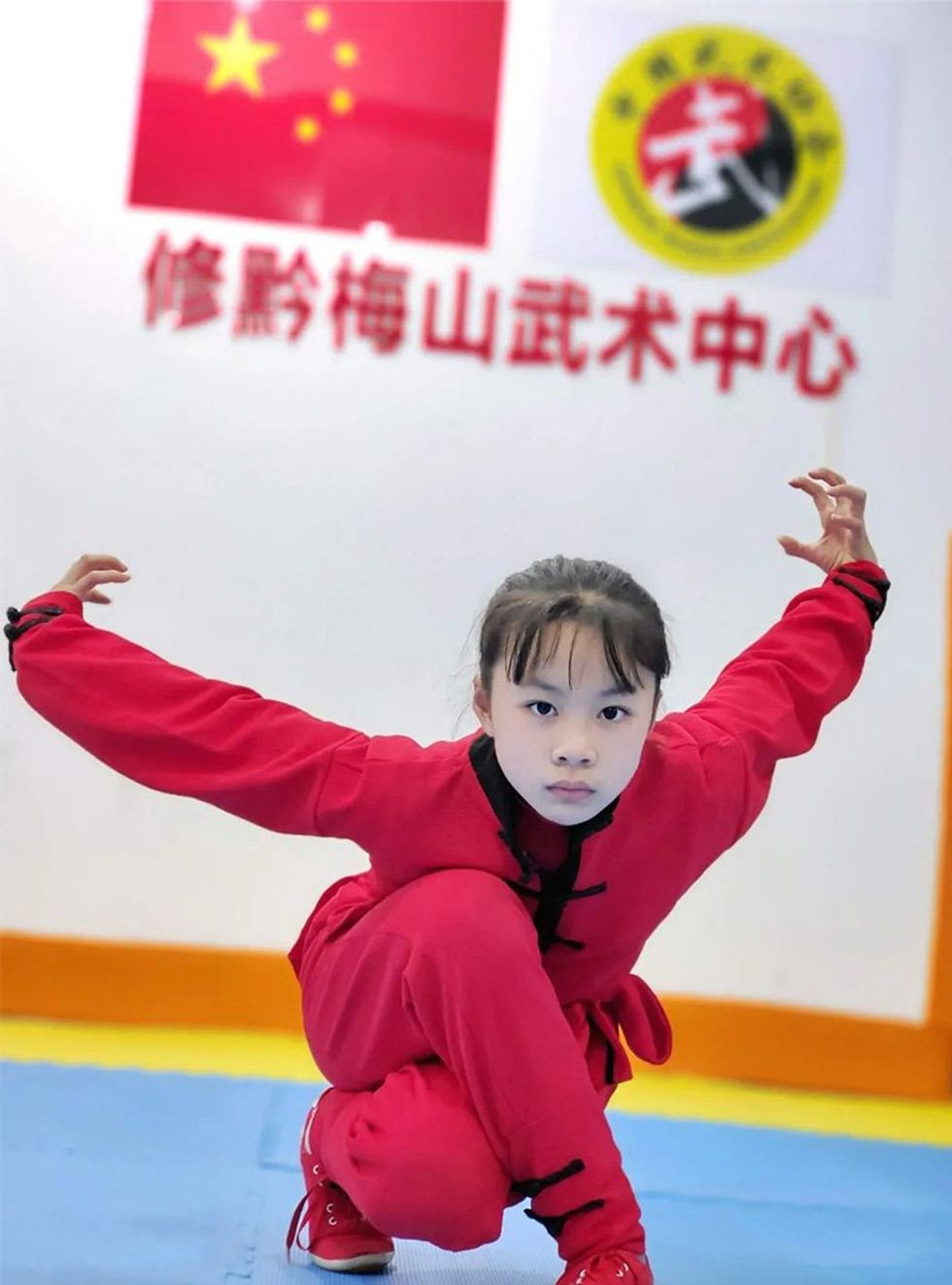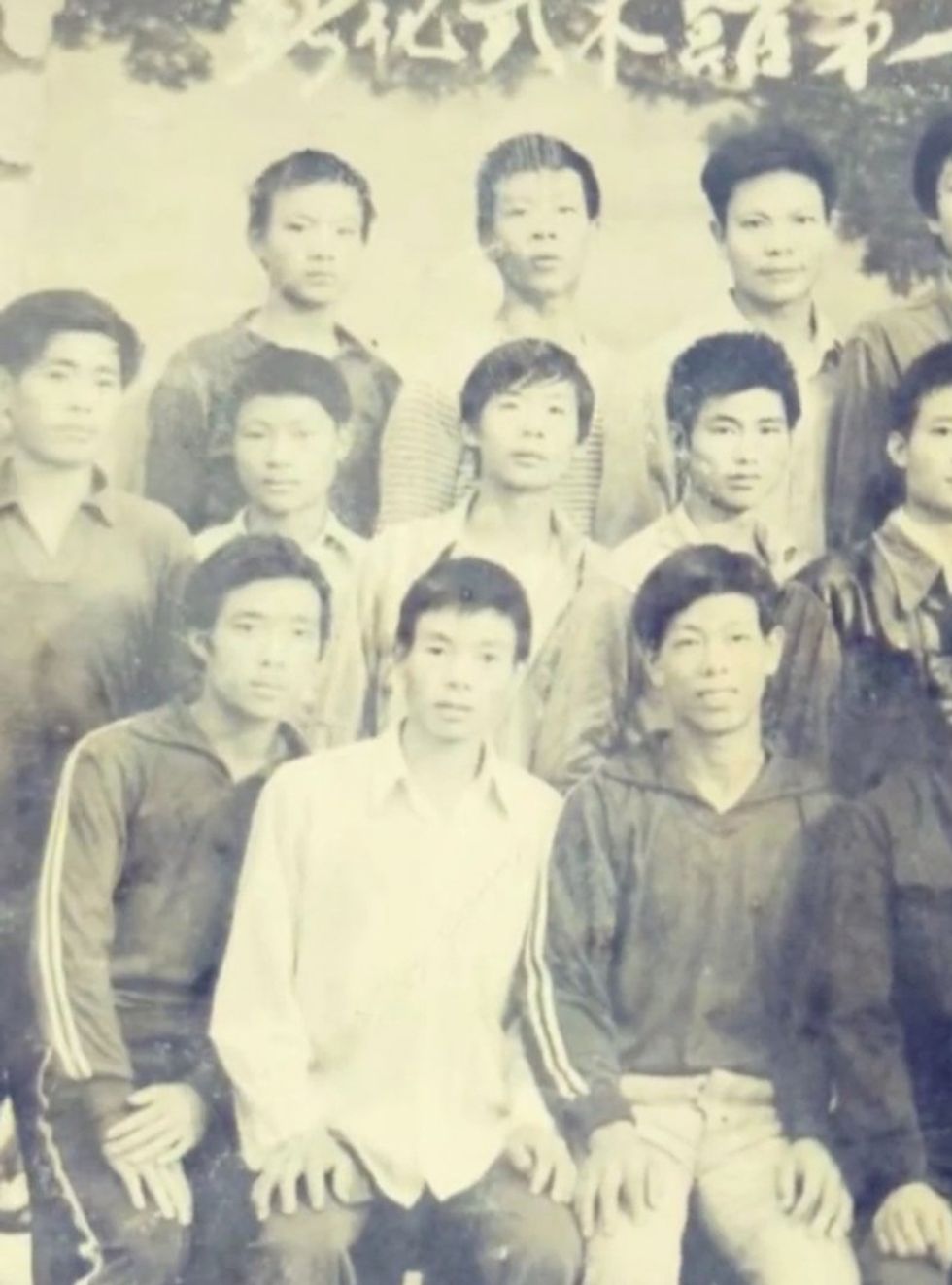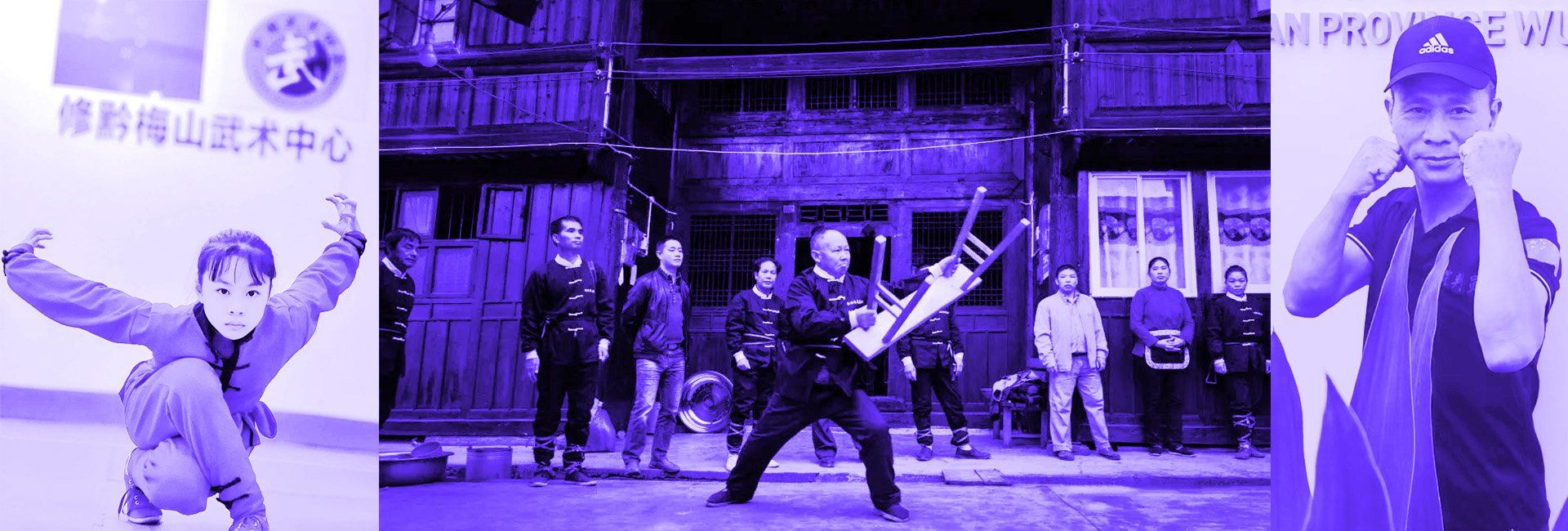From 'killing technique' to a global exercise regimen.
The two sandbags weigh a total of five kilograms but for a little boy, only a metre tall, those bags, tied to the back of his skinny thighs, feel like they weigh a ton. His legs are spread wide and bent at a right angle at the knee, in the horse stance. A bowl of water rests on top of each thigh and occasionally, water droplets splash out as his legs tremble slightly. Sweat drips down his forehead into his eyes, irritating the five-year-old's tear ducts but he holds steady, knowing if the water bowl tips over, he will face even more brutal training.
When five-year-old Wang Xiuqian struggled with sandbags weighing first five, then 10, and 20 kilograms day after day in a small village in southern China, he never dreamed that 46 years later, the discipline behind his horse stance would become a world-class sport called wushu.
'Today's sport wushu is a way to strengthen the body but in my day, it was a way to kill.'
Today, the International Wushu Federation has member associations in 158 countries across five continents. In 2020, wushu was officially included as a competition event in the 4th Youth Olympic Games and was one of eight candidate events for the Tokyo 2020 Olympics. When the South-East Asian Games open in Phnom Penh, Cambodia on Friday, May 5, wushu will be on the program.
Wushu, which translates as “martial technique”, is divided into two disciplines: taolu and sanda. A taolu performance requires a competitor to perform a series of martial arts movements arranged in sets. Sanda is a modern unarmed combat sport that primarily involves kicking, punching, throwing, and deploying defensive techniques, with 11 weight categories for men and seven weight categories for women.

"When I was a kid, I thought it was so cool that people in wushu movies could fly over walls, so I wanted to learn it too. But when I grew up, I realised that practicing wushu doesn't let you fly over walls," Wang, now a coach, said with a laugh.
Coach Wang’s body, though not tall, is very athletic. He has a thin face, an aura of "gentle coercion" and he speaks with a distinct dialect. Concerned that I might struggle to understand him, he arranged for a translator, apologising for his limited proficiency in Mandarin. He is a sixth-degree Chinese wushu practitioner, national wushu referee and standing committee member of the Hunan Province Wushu Association.
'Savage' Village
In 1969, Wang Xiuqian was born in a small village in Xinhua County, southern China. This county is the birthplace of the Meishan wushu tradition, which is recognised by the Chinese government as having national intangible cultural heritage significance. Wang's father, a wushu master, was the 19th-generation inheritor of Meishan wushu and his brother, sisters, and daughter have all studied martial arts.
It takes 40 years to learn wushu, and 30 years is spent practicing the horse stance.
Xinhua County was formerly known as "Savage Meishan", meaning that the area was a wasteland and not subject to legal constraints. It was not until the Song Dynasty (920-1279 CE) that it was included in the jurisdiction of the imperial court. During their difficult lives of farming and hunting, the ancestors of this region created the unique Meishan boxing style to fight against beasts and defend against bandits, based on the posture of wild beasts in the mountains.
Meishan wushu emphasises practicality, with no fancy movements such as spinning and backflips, and each palm is intended for attacking or defending. Moreover, the weapons used are unique. During the Yuan Dynasty (1279-1368 CE), the court had very strict control over civilian weapons and iron tools, and even kitchen knives were shared among several households. Therefore, Meishan people often used daily objects such as benches, smoking pipes, and carrying poles as weapons, which have been preserved to this day.
Iron legs, iron palms
There is a proverb in Xinhua County: "It takes 40 years to learn wushu, and 30 years is spent practicing the horse stance." In addition to tying sandbags to the legs and balancing bowls of water while to maintain stability in the horse stance, other common training methods include "dodging the ball" and the "one incense stick". “Dodging the ball” involves suspending a ball from the ceiling with a rope and hitting it forcefully so that it bounces back after hitting the wall. The apprentice, in a horse stance, can only move their upper body left and right to dodge the ball. “One incense stick” involves burning an incense stick under the buttocks. If the height of the horse stance cannot be maintained, the incense stick will burn the buttocks.

Besides emphasising the stability of legs, Meishan wushu also believes that "three punches are not as powerful as one palm, and three palms are not as powerful as one finger", and they prefer to train palms and fingers. The most common way is to fill a wooden barrel with rice husks, and then use palm strikes and finger inserts to hit the rice every day. Over time, the rice husks will be ground into powder by hand. When calluses form on the hands and pain is reduced, the rice husks are replaced with sand for practise.
Throughout his childhood, Coach Wang followed a strict training regime. Each day, he rose at 4:30 with the crowing of the rooster. Before school started at 9, he would train with sandbags tied to the legs, doing horse stances, then running, before moving the cattle out to graze. After school, training continues until late at night, smashing books nailed to trees into pieces with his bare hands and pounding bags of rice husks into powder.
Life and death battle
"Today's sport wushu is a way to strengthen the body,” Wang said, “but in my day, it was a way to kill."
Traditional Chinese wushu has always been a means for ancient people to protect their families and livelihoods. Before the 20th century, wushu competitors did not use protective gear and before each match, each competitor had to sign a "life and death contract". Wushu was a life and death battle.
In 1938, a 22-year-old named Chen Weinan achieved overnight fame when he fought seven matches in a row bare-handed in a Republican-era wushu tournament. No one could defeat him. This one battle built his legend and many would-be apprentices came to learn wushu from this master, including, more thanfour decades later, a 13-year-old Wang Xiuqian.
Master-apprentice teaching has always been the main means of passing on knowledge in Chinese traditional wushu. Only apprentices who present a letter to the master, and have it accepted, can be called "indoor disciples", so the initiation ceremony is an extremely solemn occasion. After selecting an auspicious day, the apprentice must first offer incense and kowtow to the ancestral master, then hold the prepared letter to the master over their head, offer it to the teacher with both hands, and kowtow three times. If master agrees to accept the apprentice, they will hand the apprentice a bowl of tea to drink, called the "renaming tea", indicating that from now on, the apprentice may call them master.

The initiation ceremony usually requires four witnesses to be present, who must also sign the letter of apprenticeship. Most masters will only accept a few disciples in their lifetime. Once an apprentice becomes a disciple, they must abide by the rules of the wushu world. As the Chinese proverb says, "one day as a teacher, lifelong as a father", emphasising the long-term impact that a good teacher can have on a student.
Over time, the way wushu is taught has gradually shifted from one-on-one instruction to classroom teaching. It has become a practise project in primary and secondary school physical education classes in Xinhua County. In the Xinhua Sports Boxing Club founded by Wang, 90 per cent of the students are children and teenagers. Wushu, like other art courses such as dance and musical study, can be used for competition and performance.
Thanks to social media, appreciation for the extraordinary skills of the wushu masters has spread around the world. After seeing one of Coach Wang's Wushu videos on TikTok, one American software engineer Rebecca excitedly messaged him: "I want to come to China and learn martial arts from you!"
High cost of global recognition
However, despite inclusion at the Youth Olympics and South-east Asian Games, the sport has never been included at senior Olympic level. Most recently, the Tokyo 2020 Olympic Organising Committee cut it from the final list of new events submitted to the IOC.
Coach Wang believes the richness and diversity of traditional Chinese wushu conflicts with the standardisation and regulation of large-scale international competitions. Of the 129 schools teaching traditional Chinese wushu, each has its own characteristics and none of them is right or wrong. For example, Meishan wushu alone has over 100 taolu routines and there are tens of thousands more taolu routines across all wushu schools, making it challenging to establish a universal standard for evaluating them.
"If wushu wants to become a more widely spread sport, it must think about what it needs to give up,” Coach Wang said. “In the process of going out [to the world], it has already given up enough, but it must give up more."
Tina is studying for a Master's in Journalism and Communication at UNSW Sydney. She is very interested in traditional Chinese heritage and documentaries; she loves to tell the stories of ordinary people through her writing.






Afraid of an egg: the tyranny of living with social media's body standards